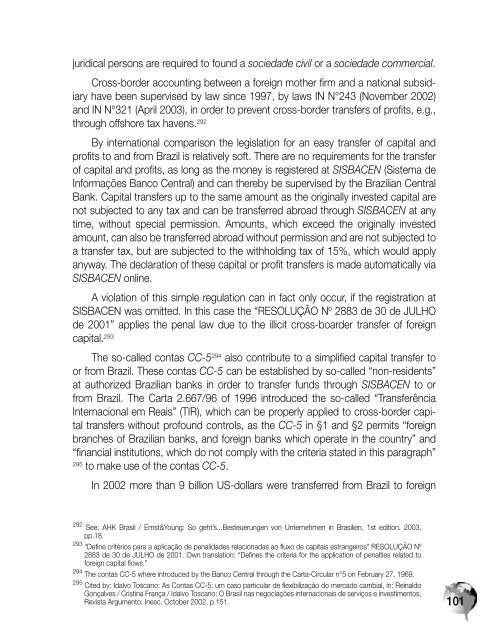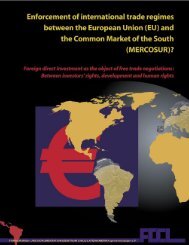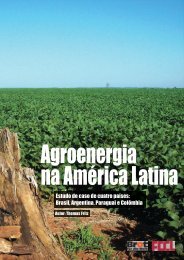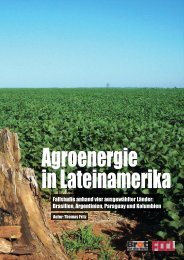(EU) and the Common Market of the South (MERCOSUR)? - FDCL
(EU) and the Common Market of the South (MERCOSUR)? - FDCL
(EU) and the Common Market of the South (MERCOSUR)? - FDCL
Create successful ePaper yourself
Turn your PDF publications into a flip-book with our unique Google optimized e-Paper software.
juridical persons are required to found a sociedade civil or a sociedade commercial.<br />
Cross-border accounting between a foreign mo<strong>the</strong>r firm <strong>and</strong> a national subsidiary<br />
have been supervised by law since 1997, by laws IN N°243 (November 2002)<br />
<strong>and</strong> IN N°321 (April 2003), in order to prevent cross-border transfers <strong>of</strong> pr<strong>of</strong>its, e.g.,<br />
through <strong>of</strong>fshore tax havens. 292<br />
By international comparison <strong>the</strong> legislation for an easy transfer <strong>of</strong> capital <strong>and</strong><br />
pr<strong>of</strong>its to <strong>and</strong> from Brazil is relatively s<strong>of</strong>t. There are no requirements for <strong>the</strong> transfer<br />
<strong>of</strong> capital <strong>and</strong> pr<strong>of</strong>its, as long as <strong>the</strong> money is registered at SISBACEN (Sistema de<br />
Informações Banco Central) <strong>and</strong> can <strong>the</strong>reby be supervised by <strong>the</strong> Brazilian Central<br />
Bank. Capital transfers up to <strong>the</strong> same amount as <strong>the</strong> originally invested capital are<br />
not subjected to any tax <strong>and</strong> can be transferred abroad through SISBACEN at any<br />
time, without special permission. Amounts, which exceed <strong>the</strong> originally invested<br />
amount, can also be transferred abroad without permission <strong>and</strong> are not subjected to<br />
a transfer tax, but are subjected to <strong>the</strong> withholding tax <strong>of</strong> 15%, which would apply<br />
anyway. The declaration <strong>of</strong> <strong>the</strong>se capital or pr<strong>of</strong>it transfers is made automatically via<br />
SISBACEN online.<br />
A violation <strong>of</strong> this simple regulation can in fact only occur, if <strong>the</strong> registration at<br />
SISBACEN was omitted. In this case <strong>the</strong> “RESOLUÇÃO Nº 2883 de 30 de JULHO<br />
de 2001” applies <strong>the</strong> penal law due to <strong>the</strong> illicit cross-boarder transfer <strong>of</strong> foreign<br />
capital. 293<br />
The so-called contas CC-5 294 also contribute to a simplified capital transfer to<br />
or from Brazil. These contas CC-5 can be established by so-called “non-residents”<br />
at authorized Brazilian banks in order to transfer funds through SISBACEN to or<br />
from Brazil. The Carta 2.667/96 <strong>of</strong> 1996 introduced <strong>the</strong> so-called “Transferência<br />
Internacional em Reais” (TIR), which can be properly applied to cross-border capital<br />
transfers without pr<strong>of</strong>ound controls, as <strong>the</strong> CC-5 in §1 <strong>and</strong> §2 permits “foreign<br />
branches <strong>of</strong> Brazilian banks, <strong>and</strong> foreign banks which operate in <strong>the</strong> country” <strong>and</strong><br />
“financial institutions, which do not comply with <strong>the</strong> criteria stated in this paragraph”<br />
295 to make use <strong>of</strong> <strong>the</strong> contas CC-5.<br />
In 2002 more than 9 billion US-dollars were transferred from Brazil to foreign<br />
292<br />
See: AHK Brasil / Ernst&Young: So geht’s...Besteuerungen von Unternehmen in Brasilien, 1st edition. 2003,<br />
pp.18.<br />
293<br />
“Define critérios para a aplicação de penalidades relacionadas ao fluxo de capitais estrangeiros” RESOLUÇÃO Nº<br />
2883 de 30 de JULHO de 2001. Own translation: “Defines <strong>the</strong> criteria for <strong>the</strong> application <strong>of</strong> penalties related to<br />
foreign capital flows.”<br />
294<br />
The contas CC-5 where introduced by <strong>the</strong> Banco Central through <strong>the</strong> Carta-Circular n°5 on February 27, 1969.<br />
295<br />
Cited by: Idalvo Toscano: As Contas CC-5: um caso particular de flexibilização do mercado cambial, in: Reinaldo<br />
Gonçalves / Cristina França / Idalvo Toscano: O Brasil nas negociações internacionais de serviços e investimentos,<br />
Revista Argumento: Inesc, October 2002, p.151.<br />
101









